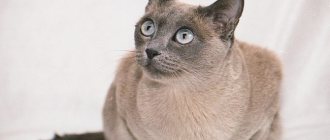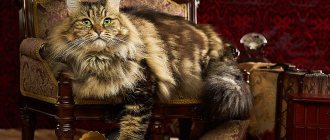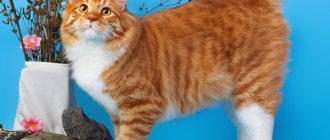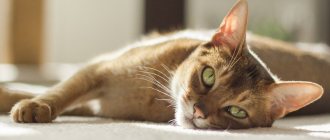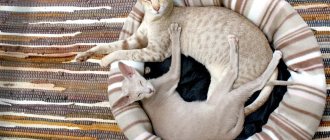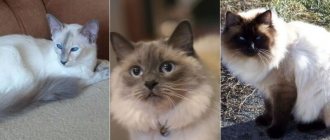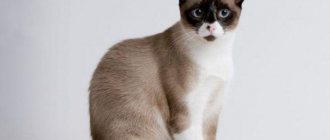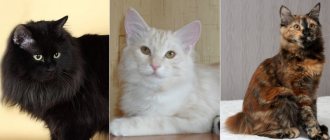May 23, 2018
The Tonkinese cat (Tonkinese) is a breed that was bred by breeders by crossing a Siamese and a Burmese cat. The Tonkinese became the first purebred cat to have aquamarine eyes. In addition to this, the newly created breed has collected a set of the best qualities from each parent breed.
History of the breed
There is a version that the first mention of these animals is found in the treatises of Siam and it was these animals that were brought to England in the nineteenth century under the guise of a chocolate Siamese. But the Siamese cat breed standard was formed in a different way and has undergone great changes.
Whether the Tonkinese cat is an “old” type of Siamese or not will never be known for certain, no matter how much felinologists argue.
In the sixties of the last century, Canadian breeder Margaret Conroy got a kitten by crossing Siamese and Burmese breeds and began to work on a new variety, naming it after the Vietnamese region of Tonkin. After the standard was written, many years of breeding work took place.
For fifteen years this cat was listed as a hybrid breed. True, this variety was originally called the “golden Siamese” because of its characteristic mink-like coat and color-point color.
The history of the name of the breed is romantic. In the USA there is a popular musical about the love of an American officer and a Tonkinese girl - the story takes place on the Pacific Islands. The moral of the story is the victory of high feeling over racial prejudice. The difficult fate of these cats, their long lack of recognition was the reason for this analogy. But the name “Tonkinese” was originally associated with the musical, in which the main character is a resident of Tonkin.
An Old Siamese cat named Wong Mau was brought to the United States of America by Dr. Joseph Thompson back in 1930. Her descendants became breeding animals - they were crossed with the Canadian line and the march of the Tonkinese cat began in America.
Today this breed is recognized by all felinological associations, but there are two standards: European and American.
Origin
The history of the origin of Tonkinese cats, or Tonkinese, is very complicated - cats with the corresponding appearance appeared in different centuries in different parts of the world.
In Asia in the 17th-18th centuries, similar cats were favorites of aristocrats, and in Europe, the first mentions of “Siamese” cats with an unusual golden color and sea-green eyes lead to England at the end of the 19th century.
But, of course, there is no evidence that these were the first representatives of the Tonkinese breed, therefore these are only beautiful legends.
Directed selection of the breed began a little more than half a century ago in Canada. Felinologist Margaret Conroy conducted an experiment: she crossed a Siamese cat with a Burmese cat, wanting to get the Burmese body shape and the acromelanic color of the Siamese. The first litter was successful - the kittens were born with light brown fur and aquamarine eyes. The breed was called the “Siamese golden cat.”
Since 1965, the breed began to participate in Canadian exhibitions. In 1971, the Golden Siamese cat was renamed the Tonkinese cat, and a few years later the Tonkinese cat was officially recognized in Canada, America and Great Britain.
Features and breed standard
In terms of morphology, the Tonkinese cat resembles a Thai cat, but has a shorter and wider, slightly snub nose. This is an animal of medium size and constitution with a peculiar coat and a characteristic color point. Derived from crossing a Siamese and a Burmese, it is distinguished by its aquamarine eye color.
Description given to this breed by WCF:
- Head. Wedge-shaped, quite wide. The profile and cheekbones are quite softly outlined, the stop is small in size on the bridge of the nose.
- Neck. Medium size, strong and muscular.
- Eyes. Quite widely spaced, almond-shaped, but slightly rounded. The color must match the coat. From aquamarine to seawater color. Preferably clean and clear tones.
- Ears. The middle ones are wider at the base, tapering to slightly rounded tips. High standing, straight, not too wide apart. The fur on the ears is short, the ears appear translucent.
- Body. Medium build, muscular, with a toned stomach. Not elegant, but not massive either.
- Paws. Medium size, quite graceful, but strong, pads are round, but quite small.
- Tail. Medium size, proportional to the body, slightly tapering towards the tip.
- Wool. Short and shiny. Without undercoat, lying close to the body.
- Color. The main background is without a pattern, uniform, somewhat lighter on the inner parts of the body. The points—the “mask” on the face, the ears, paws, and tail—are darker, the transition from the main background to the points is smoothed out.
- Weight. Males are larger than females. From three to six kilograms.
- Knitting. Interbreeding only within the breed
- Flaws. Slight deformation of the tail, too heavy or graceful body, large snub nose.
Disqualifying signs:
- Yellow eye color
- White spots and medallions
- Tail break
- Aggressive behavior.
Colors
This is the only cat whose six, one of the main advantages of the breed, are compared to a mink. It was the delicate shades of color and its brilliant gloss - glitter - that gave the colors such a name.
There are five main colors of the Tonkinese cat. Their characteristics:
- Natural mink. The main background is light brown, the points are dark brown. The abdomen and inner surfaces of the paws are lighter than the rest of the body. The paw pads and nose are light to dark brown.
- Honey mink. The main background is cream with a golden-apricot tint. The points are red-brown of varying intensity. The paw pads and nose are the color of pink caramel.
- Champagne. The main background is light cream, the points are light brown. The paw pads and nose are a cinnamon shade of varying intensity.
- Blue mink. The main background is light gray with a bluish tint, the points are darker, smoky blue. Paw pads and nose - match the background color.
- Platinum mink. The main background is silver-gray, almost purple. Points are the same color, but more saturated with a purple gloss. The paw pads and nose are pink to gray with a lavender tint.
Some felinological systems combine honey and champagne mink into one category. In addition, the Siamese type of color is sometimes recognized - with a clear contrast from the background to the points, a solid Burmese color. The mink color is often classified as a mink color.
The formation of colors is completely completed no earlier than one and a half years. Therefore, in kittens and young individuals, lighter background colors and faint spots in the points are allowed.
Character
The Tonkinese has taken the best from both breeds that created it. He is energetic and active, like a Siamese, but more silent, obedient and flexible, like a Burmese.
The soft and loyal pet always tries to be close to its owner. Strives to be picked up and loves to sleep with people.
Just like the Siamese, they love to talk, but at the same time they make quiet meowing sounds and are not so intrusive. They will feel sad when they are alone, so it is better to have a couple of these cats at home or, in addition to Tonkinesis, buy other pets.
They are smart, quickly learn to use the toilet and scratching post, and love to go for long walks with their owner on a leash, if you instill a love for a harness at an early age.
Castration and sterilization
Castration involves the complete removal of an animal's genitals. This will deprive the cat of the testes, and the cat - the uterus and ovaries. This type of operation is more effective and does not leave the animal handicapped.
Sterilization involves eliminating the possibility of becoming pregnant without removing organs. For cats, the spermatic cords are surgically ligated, and for cats, the ovaries are ligated (or the uterus is removed). This method preserves all hormonal urges in pets and, as a result, the habit of cats to mark territory, and cats to attract the attention of the male with loud cries. It is also common for both sexes to experience discomfort in the absence of a partner.
At what age is it recommended to have surgery?
Cats are spayed between 7 and 12 months of age and neutered after reaching 8 months. Cats are operated on between the ages of 10 months and 1.5–2 years. The exact period must be clarified during a consultation with a veterinarian. When choosing the moment for the operation, you need to pay attention to the fact that the younger the animal, the easier it will tolerate the procedure.
Education, maintenance and care
Tonkinese is very easy to care for. The wool has no undercoat, shedding does not bother either the owner or the animal. It is enough to remove sparse changing hair from the pet’s body with wet hands.
There is also no need for combing. To massage the skin, this procedure, if the cat likes it, can be carried out once a week. But this must be done carefully, with a brush with a soft hair base, so as not to damage the delicate skin.
You should not leave your cat alone near an open window, especially on high floors. Playfulness is characteristic even of older animals. If you get carried away with hunting for insects, they can easily fall out.
Tokinesis has virtually no drawbacks; its second name, Golden Siamese, suits it extremely well.
Care features: washing, combing, hygiene
There are no complicated procedures in caring for Tonkinese wool. The cats are washed once every six months or as needed. Cats are self-grooming animals, so they don't need frequent bathing.
See also: Serengeti cat - the standard of stateliness and greatness
Combing is done once every 5-7 days. During the shedding period, the frequency of brushing can be increased.
Once a month, the cats' claws are trimmed with special pliers. Clean ears and eyes as needed. The ears are cleaned with a special solution, and the eyes can be wiped with chamomile decoction.
Health and nutrition
Any cat can eat natural food. But in this case, it is very difficult to organize a balanced diet; it is necessary to use additional special supplements and vitamins. Therefore, after kittens are weaned from their mother, they are gradually transferred to super-premium dry ready-made food.
These are heat-loving animals; drafts should be avoided. Prolonged exposure to the sun is also useless - delicate fur can fade.
No characteristic diseases have been noted in this breed. As you age, gum problems may arise. To prevent them, you should be attentive to your pet and promptly contact a veterinarian.
To prevent diseases it is necessary:
- deworm the animal once every three months;
- regularly treat external parasites;
- Be vaccinated annually against rabies and all known feline infections.
Attachment to family
Cats get along well with one person or in large families. The main thing is to respect your pet and pay attention to it every day. If there are already other animals in the house, the Tonkinese kitten will quickly get used to them. This breed will even establish contact with birds and hamsters.
When bringing adult animals into your home, remember that Tonkinese are quite picky about the issue of personal space. They may see the presence of other small animals as a problem.
Cost of a kitten
Despite the wide distribution of the Siamese breed, it is almost impossible to find real Tonkinese in our country.
If you want to become the owner of just such a pet, you should contact one of the nurseries in the United States of America, Canada or Europe.
The cost of a pet-class kitten will not be less than five hundred dollars; animals of the breeding class (for breeding) and show classes will be sold at a price of eight hundred dollars and more.
1111
Exhibitions
Before purchasing a pet, the future owner must decide whether he wants to attend exhibitions. If you have such a desire, then it is better to take a Tonkinese-type kitten, i.e. with mink coat color, because Only they can participate in exhibitions and receive titles in systems that recognize the breed. Only such animals should also be allowed for breeding, but some of the associations (TICA, AACE, CFF) do not prohibit crossbreeding of intrabreed types.
Tonkinese dogs are recognized in the WCF, TICA, ACF, CFA, GCCF, ACFA, AACE, CFF systems - before registering a pet for an exhibition, it must be taken into account that it was organized by one of these associations, otherwise it will only receive an assessment and description from an expert.
